Using outdated displays can severely limit the potential of modern imaging equipment. This technology bottleneck risks misinterpretation and hampers diagnostic confidence. Future medical displays will transform imaging with higher resolution, AI, and seamless integration.
Advancements in resolution, AI, multi-modality integration, real-time visualization, and sustainable design are revolutionizing diagnostics. These trends are setting a new standard for clinical workflows and patient care.
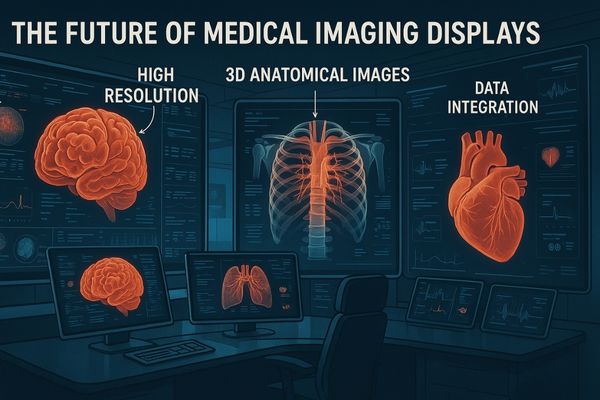
The technology behind medical imaging1 is advancing at an unprecedented pace. From more powerful scanners to sophisticated software, our ability to see inside the human body is greater than ever. Yet, the full benefit of these innovations can only be realized through the final link in the chain: the display screen. The evolution of display technology2 is therefore not just an accessory development but a fundamental driver of clinical progress. We will now examine the key trends shaping the future of this essential diagnostic tool.
Higher Resolutions Unlock New Diagnostic Possibilities
Standard screen resolutions can easily hide the tiniest, most critical details in medical scans. Missing these subtle indicators can delay a diagnosis and negatively impact patient outcomes. Ultra-high resolutions bring these crucial micro-details into sharp, clear focus.
Ultra-high-resolution displays will allow clinicians to visualize minute lesion details, enabling earlier diagnoses and more precise treatments.
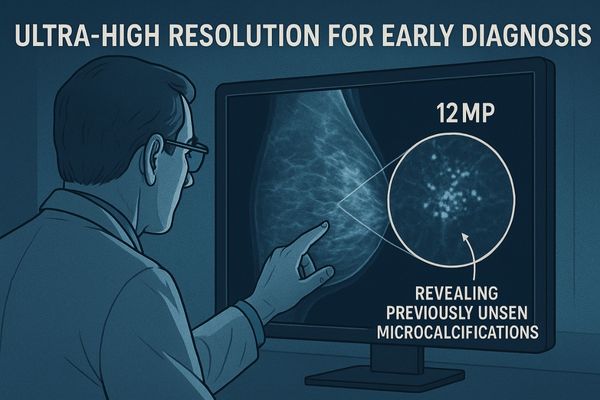
The quest for greater detail is at the heart of diagnostic imaging. The future of medical displays is firmly rooted in pushing the boundaries of resolution, moving past 4K toward 8MP, 12MP, and even higher pixel densities. This is not simply about creating a prettier picture; it is about providing clinicians with more data. In digital mammography, for example, a higher-resolution screen3 can reveal subtle microcalcification clusters that might be indistinct or invisible on a standard display. In digital pathology, it allows for a deeper, more accurate examination of cellular structures from a whole slide image without constant digital panning and zooming. This ability to see finer details directly translates to greater diagnostic confidence and the potential for earlier detection of disease. For monitors like the MD120C – 12MP High-Precision Diagnostic Monitor4 with AI Calibration, this level of detail is a foundational feature, empowering clinicians to make more informed decisions by revealing the full story hidden within the image data.
| Resolution | Total Pixels | Primary Clinical Application |
|---|---|---|
| 2MP (FHD) | ~2.1 Million | General Clinical Review, EMR |
| 5MP | ~5.2 Million | Digital Mammography, Pathology |
| 8MP (4K) | ~8.3 Million | Multi-modality Radiology, Surgical |
| 12MP | ~12.6 Million | High-Detail Mammography, Tomosynthesis |
AI-Enhanced Displays Drive Intelligent Image Interpretation
Radiologists and other clinicians face an overwhelming volume of complex images every single day. This immense workload increases the risk of mental fatigue and diagnostic errors. AI-powered displays can help by automating routine tasks and highlighting potential areas of concern.
AI-driven display technology can auto-optimize images and highlight potential abnormalities, reducing manual workload and accelerating diagnostic workflows.
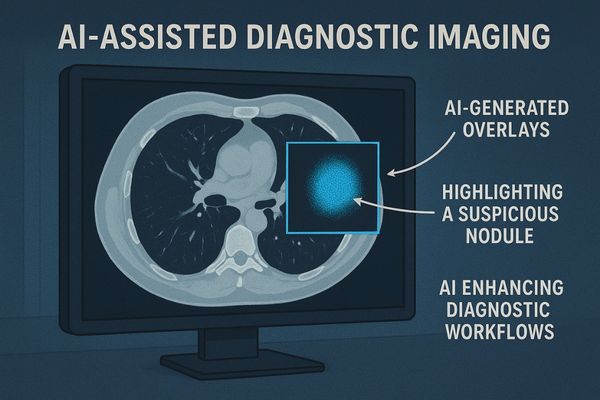
The future intelligent display will be an active partner in the diagnostic process, not just a passive screen. The integration of Artificial Intelligence5 directly into display hardware is a transformative trend. This embedded AI can perform numerous functions to streamline workflows and enhance accuracy. For example, AI algorithms can ensure the display is perpetually calibrated to the DICOM GSDF standard6, eliminating the need for manual checks and guaranteeing consistent image quality. It can also analyze the ambient light in the reading room and automatically adjust brightness and contrast for optimal viewing, reducing eye strain. More advanced AI can work in concert with PACS and CAD software to intelligently present findings, perhaps by automatically applying the best window/level presets for a specific type of scan or even flagging potential discrepancies between a report and an image. This "smart" functionality, found in advanced models like the MD85CA – 8MP Multi-modality Diagnostic Monitor, helps reduce the cognitive load on clinicians, allowing them to focus their expertise on interpretation and decision-making.
Multi-Modality Integration Simplifies Complex Clinical Workflows
Clinicians often need to switch between several different monitors to view CT, MRI, and PET scans. This constant visual and mental shifting is inefficient and makes it difficult to form a complete diagnostic picture. A single, large-format display can show all modalities at once.
Multi-modality integration enables clinicians to view CT, MRI, and ultrasound data on a single display, fostering more comprehensive clinical decisions.
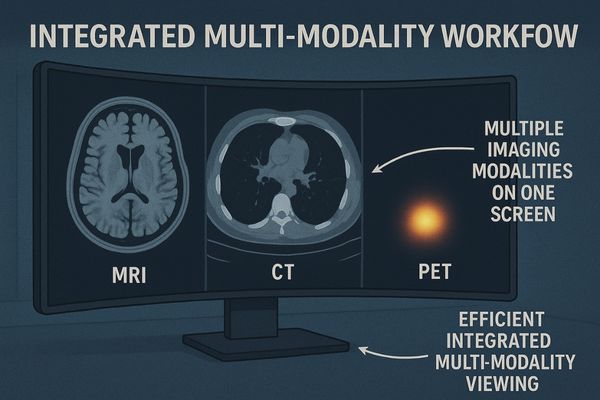
Modern patient diagnosis is rarely based on a single image. It often requires synthesizing information from multiple imaging modalities taken at different times. The traditional setup of using two, three, or even four separate monitors creates a disjointed and inefficient workflow. The future lies in large-format, single-panel displays7 that can seamlessly show multiple inputs simultaneously. Using features like Picture-by-Picture (PBP) and Picture-in-Picture (PIP)8, a clinician can arrange a patient’s MRI, CT, and PET scans side-by-side on one screen. This is a game-changer for comparative analysis, such as tracking tumor progression over time or planning a complex surgical approach. It provides a holistic patient overview that is impossible to achieve when glancing between different screens. Displays like the MD46C – Dual-screen Diagnostic Monitor (Single Panel) are specifically designed to replace cluttered dual-monitor setups, providing a unified, panoramic workspace that simplifies workflows and supports more integrated, data-driven clinical decisions, especially in environments like tumor boards or interventional radiology.
| Modality | Key Information Provided | Benefit of Fusion Display |
|---|---|---|
| CT | Detailed anatomical structure, bone | Compare bone structure with soft tissue from MRI. |
| MRI | Excellent soft tissue contrast | Overlay on CT to plan surgical paths. |
| PET | Metabolic activity, cellular function | Fuse with CT/MRI to pinpoint active tumors. |
Real-Time Visualization Supports Minimally Invasive Surgery
Minimally invasive surgery depends entirely on the image the surgeon sees on the display screen. Any video lag, color inaccuracy, or lack of detail can lead to procedural errors with critical consequences. Advanced displays provide instant, high-fidelity visualization that surgeons can trust.
Real-time imaging will provide dynamic guidance during minimally invasive surgeries, helping surgeons react swiftly and enhance procedural safety.
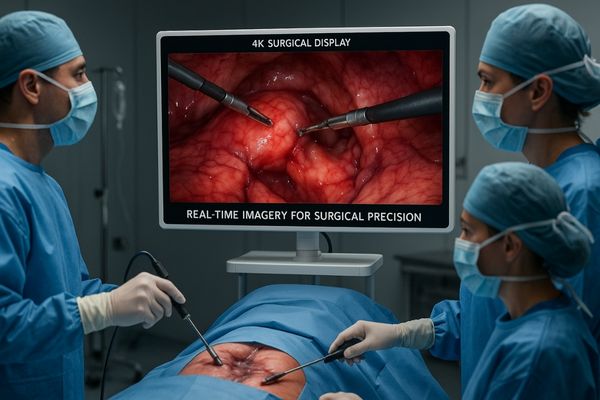
In the modern operating room, the surgical display9 is the surgeon’s window into the patient. For endoscopic, laparoscopic, and robotic procedures, the quality of this view is paramount. The future of surgical displays is defined by real-time performance. This means near-zero latency, ensuring the image on the screen is perfectly synchronized with the surgeon’s hand movements. It also means ultra-high resolution10 (4K and beyond) and an extremely wide color gamut, enabling the accurate differentiation of subtle variations in tissue, blood vessels, and nerve bundles. This high-fidelity image provides the surgeon with more confidence, allowing for more precise movements and potentially reducing procedure time and improving patient outcomes. Advanced displays can also offer multi-image layouts, showing the live endoscopic view alongside vital signs or a pre-operative CT scan for reference. For a device like the MS321PB – 32" 4K Surgical Monitor, delivering this instant, crystal-clear, and color-accurate image is its primary function, turning technology into a seamless extension of the surgeon’s own senses.
Green and Ergonomic Designs Align with Future Healthcare Trends
Spending long hours in front of screens inevitably leads to eye strain and physical discomfort for clinicians. This accumulated fatigue can reduce diagnostic performance and negatively affect long-term occupational well-being. Future displays are being designed to prioritize both energy efficiency and user ergonomics.
Future displays will be more energy-efficient, low blue light, and ergonomically designed, supporting green healthcare initiatives and improving clinician comfort.
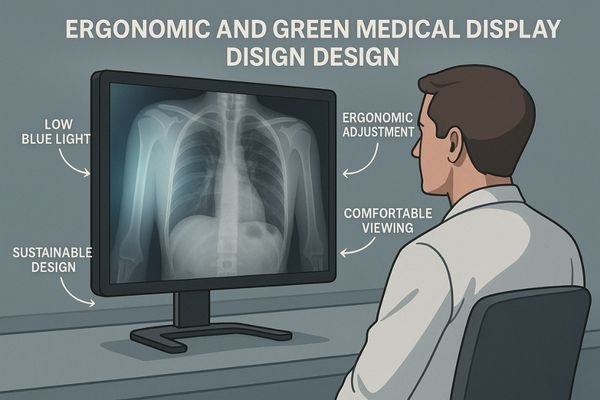
The future of healthcare technology is not just about performance; it is also about sustainability11 and human-centric design. Hospitals are increasingly focused on green initiatives, and medical equipment must align with this trend. Future displays will consume significantly less power thanks to efficient LED backlights and intelligent power-saving modes. They will also be built with more sustainable, recyclable materials, adhering to strict environmental regulations like RoHS and REACH. At the same time, there is a growing recognition of the physical toll that long hours of screen time take on medical professionals. Ergonomics is now a central design consideration. Future displays will incorporate advanced features to mitigate this, such as hardware-based low blue light technology to reduce eye strain without distorting colors, and flicker-free backlights to prevent subconscious eye fatigue. Fully adjustable stands that allow for precise control over height, tilt, and pivot will be standard, allowing each user to create a comfortable, personalized workspace. This focus on both sustainability and user well-being is evident in well-rounded models like the MD22CA – 2MP Diagnostic Monitor.
Conclusion
Medical displays are rapidly evolving from simple screens into intelligent diagnostic partners. These advancements in resolution, AI, integration, and user-centric design will undoubtedly enhance clinical precision, workflow efficiency, and patient outcomes for years to come.
📩 Ready to explore the next generation of intelligent medical displays? Contact Martin at martin@reshinmonitors.com for expert insights and solutions from Reshin.
-
Explore this link to understand how medical imaging is revolutionizing diagnostics and patient care. ↩
-
Discover the critical role of display technology in enhancing medical imaging and improving clinical outcomes. ↩
-
Explore how higher-resolution screens enhance diagnostic accuracy and reveal critical details in medical imaging. ↩
-
Discover the advanced capabilities of the 12MP monitor that empower clinicians to improve patient outcomes. ↩
-
Explore how AI enhances diagnostic displays, improving accuracy and efficiency in medical imaging. ↩
-
Learn about the DICOM GSDF standard to understand its role in ensuring consistent image quality in diagnostics. ↩
-
Explore how large-format displays enhance workflow efficiency and improve patient diagnosis in medical settings. ↩
-
Learn how PBP and PIP features can revolutionize the way clinicians analyze multiple imaging modalities. ↩
-
Explore this link to understand how surgical displays enhance precision and outcomes in modern surgeries. ↩
-
Discover the significance of ultra-high resolution in surgical displays for improved visualization and surgical success. ↩
-
Exploring this link will provide insights into how sustainability is shaping the future of healthcare technology. ↩


